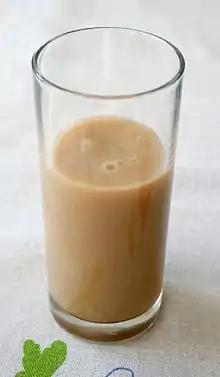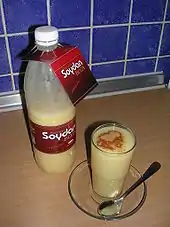Boza
Boza, also bosa, bozo is a fermented beverage popularly made in parts of North Africa, Central and Western Asia, Caucasus and Southeast Europe. It is a malt drink made by fermenting various grains: maize (corn) and wheat in Turkey, wheat or millet in Bulgaria and Romania, and barley in Ancient Egypt.[1][2] It has a thick consistency, a low alcohol content (around 1%), and a slightly acidic sweet flavor.


Etymology
According to Turkish etymological dictionary Nişanyan Sözlük, boza is etymologically either Turkic or Persian in origin. The dictionary states that Persian būza or buχsum and Old Turkic buχsı or buχsum are cognates, yet it is unclear from which language it was ultimately derived and which one took it as a loanword. The oldest written account of the drink is under the name buχsum and is attested from the 1073 Middle Turkic dictionary Dīwān Lughāt al-Turk by Mahmud al-Kashgari. Modern Turkish word boza is believed to be cognates with the Old Turkic buχsı or buχsum. The drink under the name boza is first attested in Abu Hayyan al-Gharnati's early 14th century Kipchak Turkic work Kitab al-'idrak li-lisan al-'atrak [3]
History

Fermented cereal flour (generally millet) drinks have been produced in Anatolia and Mesopotamia since the 9th or 8th millennia BCE, and Xenophon mentioned in the 4th century BCE how the locals preserved and cooled the preparations in earthen pots that were buried.[4] There are references mentioning boza-like "fermented (ground) millet drink" in Akkadian and Sumerian texts; the beverage is said to be respectively arsikku and ar-zig.[5] In the 10th century CE, the drink was called Boza and became common amongst Central Asian Turkic peoples.[6] Later it spread to the Caucasus and the Balkans. It enjoyed its golden age under the Ottomans, and boza-making became a common trade in towns and cities.
Until the 16th century, boza was drunk freely everywhere, but the custom of making the so-called Tartar boza laced with opium brought the wrath of the authorities down on the drink, and it was prohibited by sultan Selim II (1566–1574). He describes a type of non-alcoholic sweet boza of a milk white color usually made by Albanians.
In the 17th century, Sultan Mehmed IV (1648–1687) prohibited alcoholic drinks including boza, and closed down all the boza shops. This prohibition would be reinforced and then loosened several times in the history of the empire. The 17th century Turkish traveler Evliya Çelebi reports that boza was widely drunk at this time, and that there were 300 boza shops employing over a thousand people in Istanbul alone.
In this period, boza was widely drunk by the Janissaries in the army. It contained only a low level of alcohol, so as long as it was not consumed in sufficient quantities to cause drunkenness, it was tolerated as a warming and strengthening beverage for soldiers. As Evliya Çelebi explained in the first volume ("Istanbul") of his Seyahatname (Travelogues), "These boza makers are numerous in the army. To drink sufficient boza to cause intoxication is sinful but, unlike wine, in small quantities it is not condemned."[7] In the 19th century, the sweet and non-alcoholic boza preferred at the Ottoman palace became increasingly popular, while the sour and alcoholic type of boza went out of style. In 1876, brothers Haci Ibrahim and Haci Sadik established a boza shop in the Istanbul district of Vefa, close to the then center of entertainment, Direklerarası. This boza, with its thick consistency and tart flavor, became famous throughout the city. It is the only boza shop dating from that period still in business today, and is now run by the founders' great-great-grandchildren.
 Istanbul Vefa Bozaci Shop from across street
Istanbul Vefa Bozaci Shop from across street Istanbul Vefa Bozaci distribution area
Istanbul Vefa Bozaci distribution area Istanbul Vefa Bozaci Consumption area
Istanbul Vefa Bozaci Consumption area Istanbul Vefa Bozaci Glass used by Atatürk
Istanbul Vefa Bozaci Glass used by Atatürk Istanbul Vefa Bozaci Transfer to smaller vessel
Istanbul Vefa Bozaci Transfer to smaller vessel Istanbul Vefa Bozaci Transfer to smaller vessel
Istanbul Vefa Bozaci Transfer to smaller vessel
Production and storage
Boza is produced in the Balkans and most of the Turkic regions, but not always using millet. The flavour varies according to the cereal which is used. Measuring boza samples made from maize, wheat, and rice flours, researchers determined an average of 12.3% total sugar, 1.06% protein, and 0.07% fat.[8]
Boza spoils if not kept in a cool place, therefore boza fermenters in Turkey did not sell boza during the hot summer traditionally, instead selling alternative beverages such as grape juice or lemonade. They produce it in the summer now due to increased availability of refrigeration, and revenue from high demand. Serbia, Montenegro, Bosnia and Herzegovina, Kosovo, Bulgaria, Albania, and North Macedonia produce boza as a refreshing beverage year-round.
In popular culture
- Mevlut Karataş, the main character in Orhan Pamuk's 2014 novel A Strangeness in My Mind (Kafamda Bir Tuhaflık), is a boza vendor.[9]
Similar beverages
Other beverages from around the world that are traditionally low-alcohol and lacto-fermented include:
References
- Goldschmidt, Arthur (1994) Historical dictionary of Egypt Metuchen, N.J. : Scarecrow Press. page 77. ISBN 9780810829497.
- Alpion, Gëzim I. (2011) Encounters With Civilizations: From Alexander the Great to Mother Teresa New Brunswick, N. J.:Transaction Publishers. page 46. ISBN 9781412818315.
- "boza". Nişanyan Sözlük. Retrieved 2020-10-21.
- LeBlanc, Jean Guy and Todorov, Svetoslav Dimitrov (2011) "Bacteriocin producing lactic acid bacteria isolated from Boza, a traditional fermented beverage from Balkan Peninsula – from isolation to application" Archived 2018-06-13 at the Wayback Machine in Méndez-Vilas, A. (Ed.) (2011). Science against microbial pathogens : communicating current research and technological advances. Badajoz : Formatex Research Center. pp. 1311-1320.
- page 20 of Hungarian-Mesopotamian dictionary by prof. Alfred Toth, Mikes international, 2007 http://www.federatio.org/mi_bibl/AlfredToth_Mesopotamian.pdf
- Charles Perry (1983). Food in Motion: The Migration of Foodstuffs and Cookery Techniques Vol 1. Oxford Symposium. Prospect Books. p. 19. ISBN 9780907325154.
- Evliya Çelebi; Şinasi Tekin; Gönül Alpay-Tekin; Fahir İz (1989). Evliya Çelebi seyahatnamesi. Harvard Üniversitesi Basımevi.
- Zorba, Murat; Hancioglu, Omre; Genc, Mahmut; Karapinar, Mehmet; Ova, Gulden (2003). "The use of starter cultures in the fermentation of boza, a traditional Turkish beverage". Process Biochemistry. 38 (10): 1405–1411. doi:10.1016/S0032-9592(03)00033-5.
- Garner, Dwight (October 20, 2015). "Review: Orhan Pamuk's 'A Strangeness in My Mind'". The New York Times. Retrieved July 4, 2016.
External links
 Media related to Boza at Wikimedia Commons
Media related to Boza at Wikimedia Commons